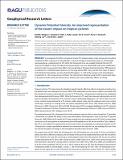| dc.contributor.author | Balaguru, Karthik | |
| dc.contributor.author | Foltz, Gregory R. | |
| dc.contributor.author | Leung, L. Ruby | |
| dc.contributor.author | Asaro, Eric D' | |
| dc.contributor.author | Liu, Hailong | |
| dc.contributor.author | Zedler, Sarah E. | |
| dc.contributor.author | Emanuel, Kerry Andrew | |
| dc.date.accessioned | 2017-06-01T17:37:46Z | |
| dc.date.available | 2017-06-01T17:37:46Z | |
| dc.date.issued | 2015-08 | |
| dc.date.submitted | 2015-06 | |
| dc.identifier.issn | 00948276 | |
| dc.identifier.uri | http://hdl.handle.net/1721.1/109509 | |
| dc.description.abstract | To incorporate the effects of tropical cyclone (TC)-induced upper ocean mixing and sea surface temperature (SST) cooling on TC intensification, a vertical average of temperature down to a fixed depth was proposed as a replacement for SST within the framework of air-sea coupled Potential Intensity (PI). However, the depth to which TC-induced mixing penetrates may vary substantially with ocean stratification
and storm state. To account for these effects, here we develop a “Dynamic Potential Intensity” (DPI) based on considerations of stratified fluid turbulence. For the Argo period 2004–2013 and the three major TC basins of the Northern Hemisphere, we show that the DPI explains 11–32% of the variance in TC intensification, compared to 0–16% using previous methods. The improvement obtained using the DPI is particularly large
in the eastern Pacific where the thermocline is shallow and ocean stratification effects are strong. | en_US |
| dc.description.sponsorship | United States. Department of Energy. Office of Science (part of the Regional and Global Climate Modeling Program) | en_US |
| dc.description.sponsorship | Atlantic Oceanographic and Meteorological Laboratory (base funds) | en_US |
| dc.language.iso | en_US | |
| dc.publisher | American Geophysical Union (AGU) | en_US |
| dc.relation.isversionof | http://dx.doi.org/10.1002/2015GL064822 | en_US |
| dc.rights | Article is made available in accordance with the publisher's policy and may be subject to US copyright law. Please refer to the publisher's site for terms of use. | en_US |
| dc.source | Prof. Emanuel via Chris Sherratt | en_US |
| dc.title | Dynamic Potential Intensity: An improved representation of the ocean's impact on tropical cyclones | en_US |
| dc.type | Article | en_US |
| dc.identifier.citation | Balaguru, Karthik, Gregory R. Foltz, L. Ruby Leung, Eric D’ Asaro, Kerry A. Emanuel, Hailong Liu, and Sarah E. Zedler. “Dynamic Potential Intensity: An Improved Representation of the Ocean’s Impact on Tropical Cyclones.” Geophysical Research Letters 42, no. 16 (August 18, 2015): 6739–6746. | en_US |
| dc.contributor.department | Massachusetts Institute of Technology. Department of Earth, Atmospheric, and Planetary Sciences | en_US |
| dc.contributor.department | Massachusetts Institute of Technology. Program in Atmospheres, Oceans, and Climate | en_US |
| dc.contributor.approver | Emanuel, Kerry | en_US |
| dc.contributor.mitauthor | Emanuel, Kerry Andrew | |
| dc.relation.journal | Geophysical Research Letters | en_US |
| dc.eprint.version | Final published version | en_US |
| dc.type.uri | http://purl.org/eprint/type/JournalArticle | en_US |
| eprint.status | http://purl.org/eprint/status/PeerReviewed | en_US |
| dspace.orderedauthors | Balaguru, Karthik; Foltz, Gregory R.; Leung, L. Ruby; Asaro, Eric D'; Emanuel, Kerry A.; Liu, Hailong; Zedler, Sarah E. | en_US |
| dspace.embargo.terms | N | en_US |
| dc.identifier.orcid | https://orcid.org/0000-0002-2066-2082 | |
| mit.license | PUBLISHER_POLICY | en_US |
| mit.metadata.status | Complete | |
